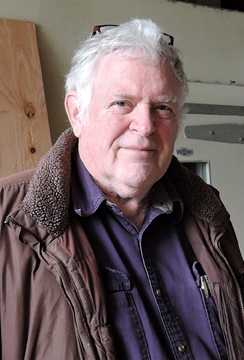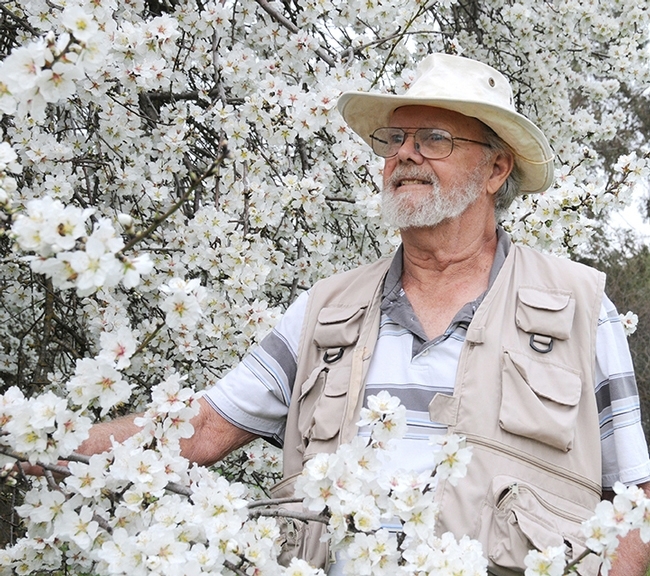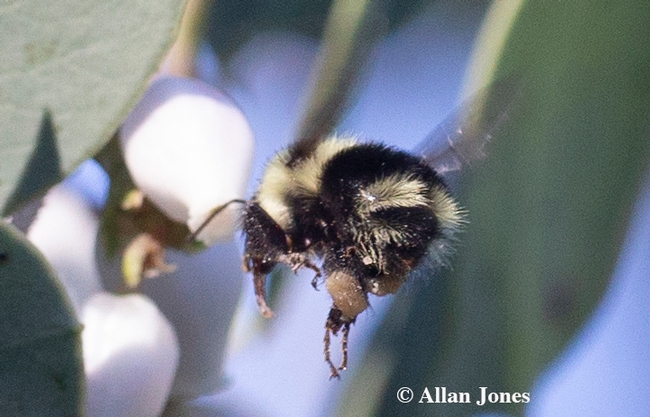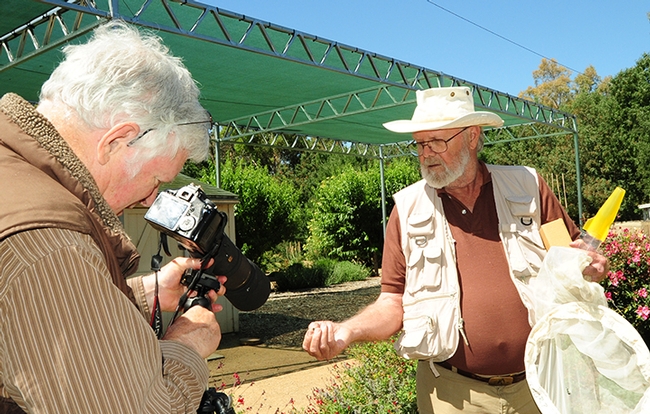
Macro insect photographer extraordinaire Allan Jones captured an image of a female black-tailed bumble bee, Bombus melanopygus on Monday, Jan. 6 on the UC Davis campus.
- The time: 1:45 p.m.
- The place: On white manzanita, just east of the 0ld Redwood Grove past the Old Davis Road/Arboretum Drive entrance, UC Davis Arboretum and Public Garden
- The temperature: About 56 degrees
"From the looks of her pollen load, she has been out collecting for some time now, so she must have been collecting earlier when it was colder yet," Jones reported. He saw one yesterday (Jan. 5 in Davis) west of El Macero but the bumble bee flew before he could photograph it. "I figured the black-tail ground nests were warmed up enough so they would be out early."
Jones, who worked closely with global bumble bee authority Robbin Thorp (1933-2019), distinguished professor of entomology at UC Davis, explained the warming of the nests:
"One summer while shooting bees soon after dawn at a lavender farm in the foothills, the first flight of bees were the bumble bees. Once it warmed up some, the honey bees showed up. So a few years ago I asked Robbin why on chill winter days I was seeing lots of honey bees, but no bumble bees. (Of course I was eager to win our contest.)
"He explained that bumble bees often nest facing north so that in cold mountainous climates, the warm southern sunshine does not warm their nests and lure them into a sudden drop in temperature or a snow squall that would kill them. Instead they wait for the ground and their nest to warm a bit before they venture out. It was Robbin's reasoning that lead me to believe that yesterday's B. melanopygus sighting in South Davis proved that local nests were warm enough that they would be flying with honey bees in the low '50s. A few years ago, the winner went out and got a shot on a day with very low temperatures as well, but she was on campus where buildings produce some tropical microclimates. This year I decided to get out early."

The Contest
A little bit about the contest: Thorp launched the contest in 2012 with a small group of bumble bee enthusiasts/photographers: Allan Jones and Gary Zamzow of Yolo County, and yours truly of Solano County. Later UC Davis doctoral student Kim Chacon with the Geography Graduate Group (and on track to receive her doctorate in June 2020), joined the group. Chacon, who studies "habitat connectivity issues for bees at a landscape scale" (see her website on Resilient Bee Landscapes), worked closely with Thorp until his death in June 2019. She is a 2018 alumnus of The Bee Course, co-taught by Thorp.
The rules are simple: the first one who photographs the first bumble bee of the year in Yolo or Solano County wins the title! (No reward, just bragging rights)
The Bee
The first bumble bee to emerge in this area is the black-tailed bumble bee, Bombus melanopygus. Native to western North America and found from California to British Columbia and as far east as Idaho, it forages on manzanitas, wild lilacs, wild buckwheats, lupines, penstemons, clovers, and sages, among others.
Thorp, a member of the UC Davis entomology faculty for 30 years, from 1964-1994, achieved emeritus status in 1994 but continued to engage in research, teaching and public service until a few weeks before his death. In 2014, during his retirement, he co-authored two books, Bumble Bees of North America: An Identification Guide and California Bees and Blooms: A Guide for Gardeners and Naturalists. He co-taught The Bee Course from 2002 to 2019. This is an intensive nine-day workshop affiliated with the American Museum of Natural History and held annually at the Southwestern Research Station, Portal, Ariz. It's geared for conservation biologists, pollination ecologists, and other biologists who want to gain greater knowledge of the systematics and biology of bees.
The Arboretum
The 100-acre UC Davis Arboretum and Public Garden, spanning the 5300-acre campus, is a landmark on the UC Davis campus--and traces its beginnings to more than 80 years ago. As the website says, it includes "demonstration gardens and scientific collections as well as the Putah Creek Riparian Reserve – a rare stream and grassland ecosystem managed for teaching, research, wildlife and habitat protection."
Go visit the Arboretum--and be sure to look for the bumble bees!
Attached Images:

Photographer Allan Jones captured this image of a black-tailed bumble bee, Bombus melanopygus, on Jan. 6 in UC Davis Arboretum and Public Garden to win the Robbin Thorp Memorial Bumble Bee Contest.

Allan Jones (left) photographs Robbin Thorp on May 22, 2012 in the Häagen-Dazs Honey Bee Haven, a half-acre bee garden on Bee Biology Road operated by the UC Davis Department of Entomology and Nematology. (Photo by Kathy Keatley Garvey)